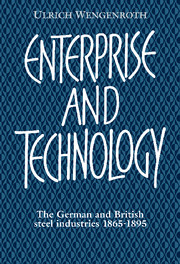Book contents
- Frontmatter
- Contents
- List of figures
- List of tables
- Preface
- List of abbreviations
- Introduction
- 1 The technology of late nineteenth-century steelmaking
- 2 Expanding into the Slump: the railways as major customers of the new steel industry
- 3 Surmounting the Slump: the individual strategies of firms
- 4 Surmounting the Slump: collective strategies
- 5 New processes and new markets
- 6 Efficiency and capacity for innovation
- Sources and bibliography
- Index
1 - The technology of late nineteenth-century steelmaking
Published online by Cambridge University Press: 18 January 2010
- Frontmatter
- Contents
- List of figures
- List of tables
- Preface
- List of abbreviations
- Introduction
- 1 The technology of late nineteenth-century steelmaking
- 2 Expanding into the Slump: the railways as major customers of the new steel industry
- 3 Surmounting the Slump: the individual strategies of firms
- 4 Surmounting the Slump: collective strategies
- 5 New processes and new markets
- 6 Efficiency and capacity for innovation
- Sources and bibliography
- Index
Summary
Nowadays we understand ‘steel’ to mean ‘all iron or iron alloy produced by smelting which is capable of being wrought or rolled’. Such a metal had indeed existed before the three steelmaking processes in which we are interested were developed by Bessemer, Thomas and Siemens-Martin.
The starting product for the steelmaking is and was, apart from insignificant exceptions, pig iron made in blast-furnaces. This metal is not suitable for most technical uses since it cannot be rolled or wrought, being brittle and unmalleable. In its pure form, it can only be used for making cast-iron wares. The reason pig iron is brittle lies in the smelting process in the blast furnaces, when both carbon and other trace elements in the iron ore are absorbed into the molten iron. Pig iron produced in this way is therefore a very complicated alloy, whose components can be influenced only to a strictly limited extent. According to the iron ore employed, its composition will vary between 92 to 95 per cent iron, 3 to 4 per cent carbon, and small quantities of silicon, manganese, phosphorus and sulphur. The brittleness of pig iron can be traced to the ‘impurity’ resulting from the 5 to 8 per cent of other elements, in particular to its high carbon content.
Now, in order to make the material called steel from pig iron, the greater part of these other elements must be removed. This procedure is called ‘refining’. (The German term is Frischen which has no equivalent in English. While in English texts ‘decarburizing’ is normally used in this context, Frischen is more than just removing carbon.
- Type
- Chapter
- Information
- Enterprise and TechnologyThe German and British Steel Industries, 1897–1914, pp. 11 - 30Publisher: Cambridge University PressPrint publication year: 1993



